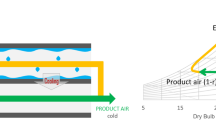Abstract
An experimental investigation in India was presented to evaluate the performance and energy saving capacity of a desiccant air-conditioning system composed of a silica gel bed, a split type air-conditioner (1.0 ton refrigeration) installed in a room with a volume of 86.4 m3, air ducts and a blower. The experiment was made in such a way that the percentages of return air, outdoor air and indoor air mixed with the air leaving the desiccant and desiccant bed thickness could be adjusted. Tests were conducted on several days with relatively similar ambient conditions. Under the test conditions in this experiment, a 7 cm bed thickness is recommended with a maximum adsorption rate of 403 g/h. The optimum percentages of air ratios were as follows: 10% of outdoor air, 10% of return air (mixed together at the desiccant bed inlet) and 80% of indoor air mixed with the dry air leaving the desiccant. The corresponding electricity saving was about 19%. As expected, simple economic analysis indicates that the desiccant air-conditioning is not viable for smaller cooling capacities.
Similar content being viewed by others
References
Beggs C B, Warwicker B. Desiccant cooling: Parametric energy study. Building Services Research and Technology, 1998, 19(2): 87–91
Beggs C B, Halliday S. A theoretical evaluation of solar-powered desiccant cooling in the United Kingdom. Building Services Research and Technology, 1999, 20(3): 113–117
Henning H M, Erpenbeck T, Hindenburg C, Santamaria I S. The potential of solar energy use in desiccant cooling cycles. International Journal of Refrigeration, 2001, 24(3): 220–229
Meckler M. Desiccant outdoor air pre-conditioners maximize heat recovery ventilation potentials. ASHRAE Transaction Symposia, 1995, SD-95-9-4
Collier Jr R K, Novosol D, Worek W M. Simulation of open-cycle desiccant cooling system performance. ASHRAE Transactions, 1990, 96(1): 1262–1268
Albers W F, Beckman J R, Farmer R W, Gee K G. Ambient pressure, liquid desiccant air conditioner. ASHRAE Transactions, 1991, 99(1): 603–608
Griffiths W C. Desiccant dehumidification reduces refrigeration loads. Energy Engineering, 1989, 86(4): 39–49
Peng C S, Howell J R.The performance of various types of regenerators for liquid desiccants. Transactions of the ASME Journal of Solar Energy Engineering, 1984, 106: 133–144
Jurinak L L, Mitchell LW, Beckman WA. Open-cycle desiccant air conditioning as an alternative to vapor compression cooling in residential applications. Journal of Solar Energy Engineering, 1984, 106(8): 252–260
Kinsara A A, Elsayed M M, Al-Rabghi O M. Proposed energy-efficient cooling system using liquid desiccant. Applied Thermal Engineering, 1996, 16(10): 791–806
Ani F N, Badawi E M, Kannan K S. The effect of absorber packing height on the performance of a hybrid liquid desiccant system. Renewable Energy, 2005, 30(15): 2247–2256
Stevens D I, Braun J E, Klein S A. An effectiveness model of liquiddesiccant system heat/mass exchangers. Solar Energy, 1989, 42(6): 449–455
Factor H M, Grossman G. A packed bed dehumidifier/regenerator for solar air conditioning with liquid desiccant. Solar Energy, 1980, 24(6): 541–550
Hirunlabh J, Charoenwat R, Khedari J, Sombat T. Feasibility study of desiccant air-conditioning system in Thailand. Building and Environment, 2007, 42(6): 572–577
Kabeel A E. Solar powered air conditioning system using rotary honeycomb desiccant wheel. Renewable Energy, 2007, 32(11): 1842–1857
Smith R R, Hwang C C, Dougall R S. Modeling of a solar-assisted desiccant air conditioner for a residential building. Energy, 1994, 19(6): 679–691
Worek W M, Moon C-J. Simulation of an integrated hybrid desiccant vapor-compression cooling system. Energy, 1986, 11(10): 1005–1021
Areemit N, Sakamoto Y. Numerical and experimental analysis of a passive room-dehumidifying system using the sorption property of a wooden attic space. Energy and Buildings, 2007, 39(3): 317–327
Nia F E, van Paassen D, Saidi M H. Modeling and simulation of desiccant wheel for air conditioning. Energy and Buildings, 2006, 38(10): 1230–1239
Author information
Authors and Affiliations
Corresponding author
Rights and permissions
About this article
Cite this article
Mittal, V., Khan, B.K. Experimental investigation on desiccant air-conditioning system in India. Front. Energy Power Eng. China 4, 161–165 (2010). https://doi.org/10.1007/s11708-009-0070-5
Received:
Accepted:
Published:
Issue Date:
DOI: https://doi.org/10.1007/s11708-009-0070-5




